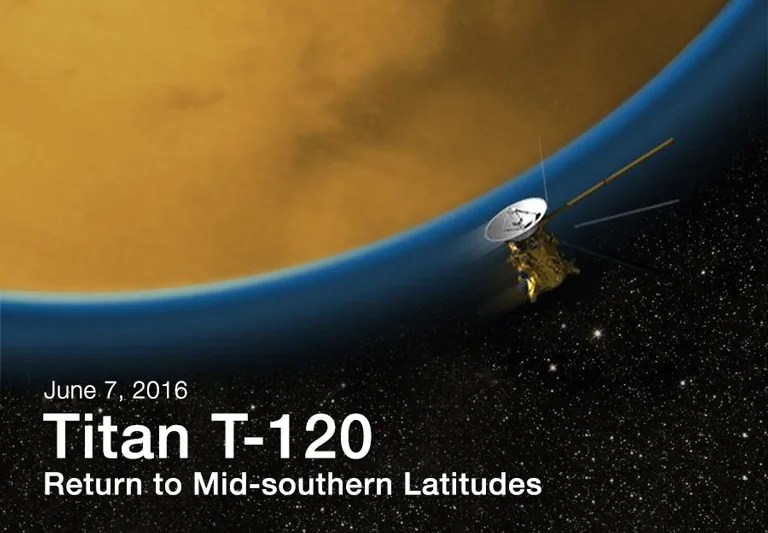4 min read

On June 7, Cassini will perform a targeted encounter of Titan, designated T-120. This is actually Cassini’s 121st flyby of Titan -- the sixth of 11 planned for 2016. The next encounter is planned for July 25.
This encounter will increase the inclination of Cassini’s orbit from 35.3 degrees to 42.4 degrees and will decrease the spacecraft’s orbital period from around month to 24 days. Inclination is being increased in preparation for the beginning of Cassini's F-ring orbits, scheduled to begin Nov. 30.
Flyby Geometry
T-120 is a mid-southern latitude pass, with closest approach occuring above the dusk (local time) region of Titan.
With regard to Saturn's magnetosphere, T-120 occurs in the late midnight sector. The Saturnian local time of the flyby is similar to that of T9, T114, T116, T117, T118 and T119. Cassini will observe the polar sector of Titan's induced magnetosphere, which was also explored during those flybys.
On Approach to Titan
The Composite Infrared Spectrometer (CIRS) will view the sub-Saturn hemisphere of Titan, acquiring nadir- and limb-sounding observations at mid- and far-infrared wavelengths. Many of these are designed to measure seasonal changes in atmospheric temperatures and trace gas abundances, particularly near the edge of Titan’s south polar vortex. The observations also include two surface temperature scans to detect seasonal changes at that may affect the retention of liquids.
CIRS will obtain maps of the inbound and outbound hemispheres in the lower stratosphere to constrain atmospheric temperatures and gas abundances. These are important for understanding the overall circulation of Titan's atmosphere.
Finally, from one hour to 30 minutes before closest approach, CIRS will measure the vertical variation of haze opacity.
ISS will ride along with CIRS, imaging Titan's sub-Saturn hemisphere at mid-southern latitudes over Tsegihi. ISS will also be imaging small, dark features in the southern hemisphere and Shangri-La just to the east of the Huygens probe landing site.
VIMS will ride along with CIRS (Titan's sub-Saturnian hemisphere at mid-southern latitudes over Tsegihi) and will observe the evolution of the South polar vortex.
Closest Approach
Radar will acquire altimetry and SAR swaths across portions of Titan’s southern and anti-Saturn hemispheres -- this is an area poorly covered by Cassini thus far, and promises to reveal new terrain. The SAR imaging swath will run from near 55 degrees south latitude, 30 degrees west longitude (northwest of Mezzoramia), toward west-southwest to 65 degrees south latitude, 90 degrees west longitude, turning northwest to cover portions of Hobal and Perkunas Virgae and Shangri-La, before ending near Texel Facula. This is the last radar SAR swath of the mission to cover high-southern latitudes on Titan.
The Ion and Neutral Mass Spectrometer (INMS) will be riding along with Radar near closest approach; this INMS observation will be compared to data from the T-71 flyby to observe the extent of seasonal changes in Titan’s atmosphere.
Outbound from Titan
Radar will carry out altimetry, HiSAR and scatterometry/radiometry observations, with multiple overlaps to constrain Titan’s rotation state.
CIRS will perform additional atmospheric compositional measurements, checking the vertical abundance profile of trace gases at the edge of Titan's southern polar vortex at 52 degrees south latitude. This is the last observation of its type during the mission, and is expected to provide important insights into the chemistry and movement of this feature above the moon's winter pole.
ISS will acquire images at high phase angle over Titan's anti-Saturn hemisphere at mid-northern latitudes.
VIMS will image Titan's surface and atmosphere, looking for specular reflections on the lakes and seas of the north polar region.
For an extra day after the Titan encounter, ISS will monitor Titan to track clouds and their evolution over mid-northern latitudes as northern summer approaches.
Date
June 7, 2016
Altitude
606 mi (975 km)
Speed (relative to Titan)
13,198 mph (5.9 km/sec)







